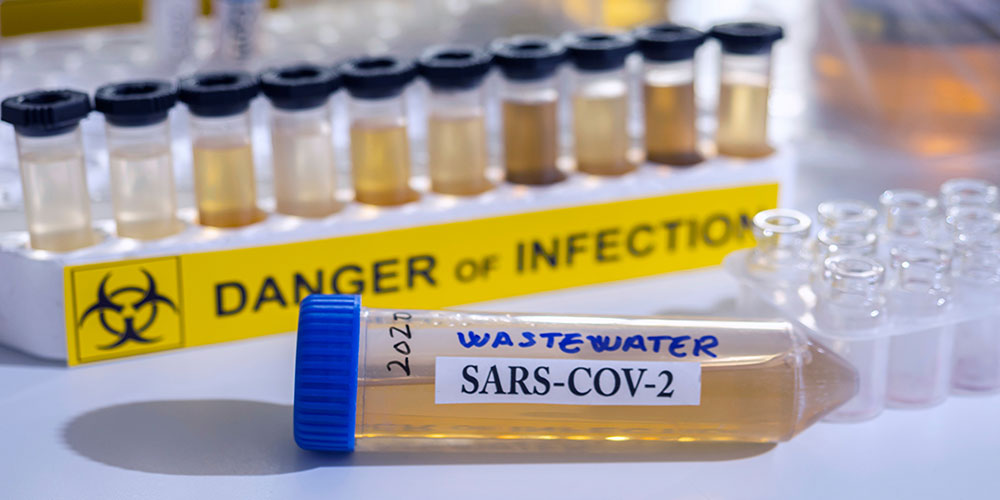COVID-19 cases have slowed down over the past several months, but it is important that campus safety officials do everything in their power to keep the virus out of the classroom and off of campus to the best of their abilities.
The pandemic has been in the U.S. since January 30th, 2020, and for the last two-and-a-half years, it has caused major disruptions to colleges and universities. In response to the challenges of the pandemic, most colleges and universities have adopted several different safety measures and programs so they can continue to provide education to students. One of those tools is COVID-19 wastewater surveillance.
Wastewater, or sewage, consists of water from building use that would include mainly bathrooms, kitchens, and laundries. Anyone on campus infected with SARS-CoV-2 can shed the virus in their feces. This will be the case even if they don’t have noticeable symptoms. Viral RNA from SARS-CoV-2 can then be detected in the campus wastewater by reverse transcriptase quantitative polymerase chain reaction (rt-qPCR) analysis.
How Does Wastewater Testing Work?
There are several questions in designing a campus wastewater surveillance program: where to sample, how to sample, how to analyze the data, and then report and use the results. The question of where to sample comes down to what questions need to be answered and if there is access to wastewater for samples to be taken. Most campus programs are conducted via a single building (dormitory or greek life house) or campus area samples (lift station or other places that consist of wastewater from several campus buildings).
How to sample is very important. The wastewater that’s collected needs to be representative of the campus population. Grab samples, a small subset of larger measurements, are usually not representative unless they are collected from an area like a lift station that holds a good amount of wastewater over time. The best way to sample is using a composite approach.
In a composite approach, a small sample is taken over time and combined into one sample. Using a composite sampling method provides the best opportunity to truly measure viral loads in a campus population. Sometimes it’s difficult to sample over time because universities are unable to afford an automatic sampler or place sampling equipment in an open area. In such cases, some practitioners have used “Moore” swabs, which are gauze pads that are suspended in a pipe of flowing wastewater to collect a sample over time.
Once the samples are collected, it’s important that they are kept cold and be provided to the lab that will run the rt-qPCR analysis as soon as possible. When the lab receives the samples, they are concentrated, and the total viral RNA is extracted and purified. Once that is complete, the RNA is analyzed with rt-qPCR analysis and the results are reported.
The reports include several pieces of information. The most useful is the amount of viral RNA from the SARS-CoV-2 virus. This is usually reported as “N1” and “N2” which represent different pieces of the SARS-CoV-2 viral RNA. The results are usually reported as gene copies per liter. Other information reported includes the amount of an added virus as a recovery standard which provides how efficient the total analysis was, and a very common virus found in human feces that is used as an environmental recovery standard.
The RNA results can be used to identify viral hot spots on campus, for example, a dormitory with extraordinarily high SARS-CoV-2 viral gene counts. The most useful application is to monitor trends over time to track if viral counts are increasing, stable, or decreasing. The wastewater data can also be combined with individual testing, which can be increased where there are hot spots. Now, wastewater samples can also be tested for variant identification and answer what are the variants that are causing illness on campus.
A Wastewater Surveillance Program Case Study
In May of 2021, Microbac Laboratories worked with Hampden-Sydney College in Virginia to test the school’s wastewater and pinpoint potential COVID-19 hot spots in specific residential buildings. The college conducted standard individual COVID-19 testing for students living in high-risk dormitories. Every week, 10% of the students were selected randomly for a test based on the wastewater results. Through the wastewater testing, the college was able to catch a significant uptick in COVID-19 after students returned from a mid-semester break. Based on the wastewater results, the college increased individual testing and quarantines to help slow the spread of the virus.
A spokesman for the college said, “When the pandemic hit, we all went virtual, and as a result, our students, across all disciplines, struggled academically. Our goal was to find a way to safely bring students back to campus for face-to-face instruction and wastewater testing was critical in making that happen.”
Wastewater testing can provide a way to monitor campus populations at a low cost, predict, and track COVID-19 outbreaks, and account for those students who have not been tested with mild or no symptoms. Additionally, wastewater testing can provide a better way to track virus variants in the student population.
Dr. Aaron Peacock is an environmental scientist with more than 25 years of experience specializing in microbial molecular diagnostics. He is the director of molecular biology at Microbac Laboratories, a private analytical and CDC-certified virology testing lab.
Note: The views expressed by guest bloggers and contributors are those of the authors and do not necessarily represent the views of, and should not be attributed to, Campus Safety.













